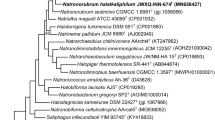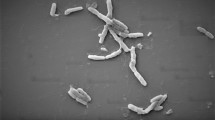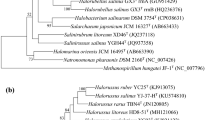Abstract
A novel member of extremely halophilic archaea, strain AJ2, was isolated from Ayakekum Lake located in Altun Mountain National Nature Reserve of Xinjiang Uygur Autonomous Region in China. The strain AJ2 requires at least 10% (w/v) NaCl and grows 10% to 30% (optimum at 20%). Phylogenetic analysis based on 16S rDNA sequence comparison revealed that strain AJ2 clustered to three Natrinema species with less than 97.7% sequence similarities, suggesting AJ2 is a novel member of Natrinema. A bacteriorhodopsin-encoding (bop) gene was subsequently detected in the AJ2 genome using the polymerase chain reaction technique. The cloning and sequencing of a 401 base pairs fragment indicated the deduced amino acid sequence of bop from AJ2 is different from that reported for bacteriorhodopsins. This is the first reported detection of a bop gene in Natrinema.
Similar content being viewed by others
References
Dunn, R., McCoy, J., Simsek, M., Majumdar, A., Chang, S.H., RajBhandary, U.L., Khorana, H.G., 1981. The bacteriorhodopsin gene.Proc Natl Acad Sci USA,78:6744–6748.
Felsenstein, J., 2003. PHYLIP. http://evolution.genetics.washington.edu/phylip.html.
Frydrych, M., Silfsten, P., Parkkinen, S., Parkkinen, J., Jaaskelainen, T., 2000. Color sensitive retina based on bacteriorhodopsin.Biosystems,54:131–140.
Gupta, R., Lanter, J.M., Woese, C.R., 1983. Sequence of the 16S ribosomal RNA fromHalobacterium volcanii, an archaebacterium.Science,221:656–659.
Ihara, K., Umemura, T., Katagiri, I., Kitajima-Ihara, T., Sugiyama, Y., Kimura, Y., Mukohata, Y., 1999. Evolution of the archaeal rhodopsins: evolution rate changes by gene duplication and functional differentiation.J Mol Biol,285:163–174.
Kyte, J., Doolittle, R.F., 1982. A simple method for displaying the hydropathic character of a protein.J Mol Biol,157:105–132.
Lanyi, J.K., Pohorille, A., 2001. Proton pumps: mechanism of action and applications.TRENDS Biotechnol,19: 140–144.
Luecke, H., Schobert, B., Richter, H.T., Cartailler, J.P., Lanyi, J.K., 1999. Structural changes in bacteriorhodopsin during ion transport at 2 angstrom resolution.Science,286:255–261.
Margesin, R., Schinner, F., 2001. Potential of halotolerant and halophilic microorganisms for biotechnology.Extremophiles,5:73–83.
McGenity, T.J., Gemmell, R.T., Grant, W.D., 1998. Proposal of a new halobacterial genusNatrinema gen. nov., with two speciesNatrinema pellirubrum nom.nov. andNatrinema pallidum nom. nov.Int J Syst Bacteriol,48:1187–1196.
Mukohata, Y., Ihara, K., Tamura, T., Sugiyama, Y., 1999. Halobacterial rhodopsins.J Biochem,125:649–657.
Oesterhelt, D., Stoeckenius, W., 1971. Rhodopsin-like protein from the purple membrane ofHalobacterium halobium.Nature,233:149–152.
Oesterhelt, D., Stoeckenius, W., 1974. Isolation of the cell membrane ofHalobacterium halobium and its fractionation into red and purple membrane.Methods Enzymol,31:667–678.
Otomo, J., Urabe, Y., Tomioka, H., Sasabe, H., 1992. The primary structures of helices A to G of three new bacteriorhodopsin-like retinal proteins.J Gen Microbiol,138:2389–2396.
Radax, C., Cruber, C., Stan-Lotter, H., 2001. Novel haloarchaeal 16S rRNA gene sequences from Alpine Permo-Triassic rock salt.Extremophiles,5:221–228.
Stackebrandt, E., Goebel, B.M., 1994. Taxonomic note: a place for DNA-DNA reassociation and 16S rRNA sequence analysis in the present species definition in bacteriology.Int J Syst Bacteriol,44:846–849.
Wang, H., Zhan, S., Sun, Q., Xu, D., Zhao, W., Huang, W., Li, Q., 2000. Primary structure of helix C to helix G of a new retinal protein in H.sp.xz515.Chinese Sci Bull,45:1108–1112 (in Chinese).
Wise, K.J., Gillespie, N.B., Stuart, J.A., Krebs, M.P., Birge, R., 2002. Optimization of bacteriorhodopsin for bioelectronic devices.TRENDS Biotechnol,20:387–394.
Xin, H., Itoh, T., Zhou, P., Suzuki, K.I., Kamekura, M., Nakase, T., 2000.Natrinema versiforme sp. nov., an extremely halophilic archaeon from Aibi salt lake, Xinjiang, China.Int J Syst Evol Microbiol,50:1297–1303.
Author information
Authors and Affiliations
Corresponding author
Additional information
Porject (No. 30370029) supported by the National Natural Science Foundation of China
Rights and permissions
About this article
Cite this article
Xu, Xw., Wu, M. & Huang, Wd. Isolation and characterization of a novel strain of Natrinema containing a bop gene. J Zheijang Univ Sci B 6, 142–146 (2005). https://doi.org/10.1631/jzus.2005.B0142
Received:
Accepted:
Published:
Issue Date:
DOI: https://doi.org/10.1631/jzus.2005.B0142




